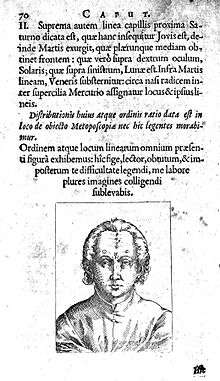Metoposcopy
Metoposcopy is a form of divination in which the diviner predicts personality, character, and destiny, based on the pattern of lines on the subject's forehead. It was in use in the Classical era, and was widespread in the Middle Ages, reaching its zenith in the 16th and 17th centuries.[1][2]

History
Pliny mentions a metoposcopos, described by Appion the Grammarian, who ("a thing incredible to be spoken") could judge a person's age and how much longer they would live. According to Suetonius, another practitioner determined that Titus, and not Britannicus, would become Emperor. Juvenal was disdainful, and considered metoposcopy to be plebeian.[3]
Metoposcopy is prominently featured in the Zohar.[4] Isaac Luria (1534 - 1572), a Syrian rabbi considered to be the founder of contemporary Kabbalah, practised a form of metoposcopy in which he interpreted the appearance of Hebrew letters on the forehead.[5][1]
Metoposcopy was developed by the 16th century Italian polymath Gerolamo Cardano, considered to be one of the foremost mathematicians of the Renaissance. His seminal work Metoposcopia libris tredecim, et octingentis faciei humanae eiconibus complexa, illustrated with engravings of 800 foreheads, was written in 1558 and published posthumously in 1658.[2][3][6] Giovanni Antonio Magini was also interested in the subject. Many metoposcopy books were published in the 16th and 17th centuries.[1]
Criticism
.jpg)
Jean Bodin denounced metoposcopy in his influential work De la démonomanie des sorciers (1580). The practise was banned by Pope Sixtus V in 1586.[2]
See also
- Frontispiece (book)
- Physiognomy
References
- Lawrence Fine (1 May 1995). Essential Papers on Kabbalah. NYU Press. pp. 317–. ISBN 978-0-8147-2623-5.
- Armando Maggi (1 September 2001). Satan's Rhetoric: A Study of Renaissance Demonology. University of Chicago Press. pp. 181–. ISBN 978-0-226-50132-1.
- Edward Smedley; Hugh James Rose; Henry John Rose (1845). Encyclopaedia Metropolitana, Or, Universal Dictionary of Knowledge: Comprising the Twofold Advantage of a Philosophical and an Alphabetical Arrangement, with Appropriate Engravings. B. Fellowes. pp. 126–.
- Matt, Daniel, "Zohar, Vol.4"
- Eisen, Yosef (2004). Miraculous journey : a complete history of the Jewish people from creation to the present (Rev. ed.). Southfield, Mich.: Targum/Feldheim. p. 213. ISBN 1568713231.
- Melissa Percival (1999). The Appearance of Character: Physiognomy and Facial Expression in Eighteenth-century France. MHRA. p. 38. ISBN 978-1-902653-07-5.